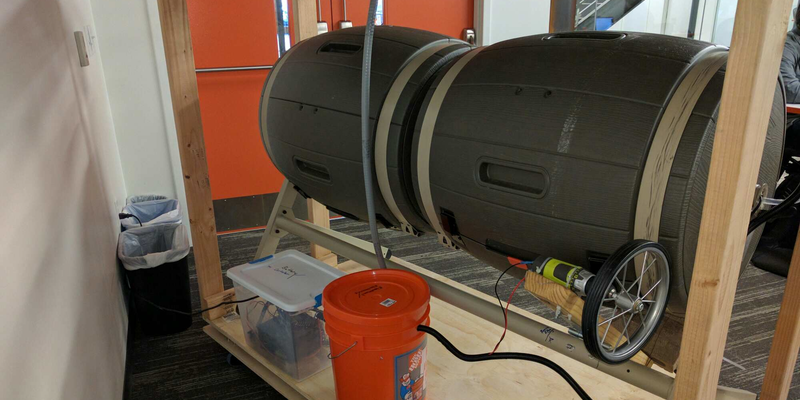A lot of people are scared of composting. After all, if the temperatures or humidity go badly wrong, you can end up with dried-out trash or a stinking soup. Getting the balance right is a secret known to the ancients: toss it in a big pile in your backyard. But what if you don’t have a big backyard?
Amalgamate is a composting setup for the urban dweller, or for people who just don’t like bugs. [Jamie] built it as her first Raspberry Pi project, and that makes it a great entrée into the world of things. But it’s no lightweight: the software measures temperature and humidity, and lets you schedule watering and rotating the compost. And of course, if you’re a micromanager, you can get up-to-the-minute vitals on your cellphone and tweak everything to run just perfectly.
On the hardware side, the Raspberry Pi breaks out into a relay board which turns and waters the compost. A drill with a wheel in its chuck rotates the barrels. [Jamie]’s setup uses a 12 V battery and a solar cell to make the system self-sufficient, but with infrequent and low power requirements, we guess there are many options here.The one trick is to get a barrel that rotates around a hole in the center to pass the wires through.
We like tech-meets-agriculture projects around here, and we think this project would make the perfect complement to your farmbot system. With LED and solar panel prices dropping, and hassle-free automation systems taking care of the work, we may be on the edge of an indoor gardening revolution. (Get it, “revolution”? It turns the compost barrels… OK, just watch the video.)


















I’ve literally never paid any attention to what goes in my heap or how long but it churns out compost fast enough that i have a barrel sackful a year.
Hey Alex- the cool thing about compost is you don’t have to pay attention to the details but the more you turn it the less methane is released because it attracts aerobic microorganisms instead of anaerobic also depending on your house size, how many people you have in it, and their specific diets (4 vegetarians who eat tons of fresh fruit/veggies plus all the garden waste here) it can fill up way too fast and not have actually gotten hot enough to kill pathogens or weed seeds which makes it less desirable to use on future gardens. By creating a simple monitoring system it lets you monitor it without having to take a lot of extra time to do so.. just cool and interesting but if it isn’t a problem you have run into that means the project might not be for you.
May FarmBot have screw type compost aerator connects with Universal Tool Mount ?